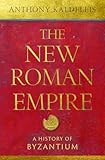The New Roman Empire : a history of Byzantium / Anthony Kaldellis.
Material type: TextPublication details: New York: Oxford University Press, 2024.Description: vii, [17], 1133 pages, 8 unnumbered pages of plates : illustrations, maps ; 24 cmISBN:
TextPublication details: New York: Oxford University Press, 2024.Description: vii, [17], 1133 pages, 8 unnumbered pages of plates : illustrations, maps ; 24 cmISBN: - 9780197549322 (hbk)
- 949.5/02 23/eng/20230321
- DF552 .K14 2024
| Item type | Current library | Collection | Call number | Copy number | Status | Notes | Barcode | |
|---|---|---|---|---|---|---|---|---|
 Books
Books
|
Rabdan Academy General Stacks | General Collection | DF552 .K14 2024 (Browse shelf(Opens below)) | C. 1 | Available | AED 148.05 | 23244 |
Browsing Rabdan Academy shelves,Shelving location: General Stacks,Collection: General Collection Close shelf browser (Hides shelf browser)

|

|

|

|

|

|

|
||
| DD101 .B876 2021 The German Way of War : a lesson in tactical management / | DF545 .B369 2020 Greece: biography of a modern nation / | DF552 .G822 2010 A History of Byzantium / | DF552 .K14 2024 The New Roman Empire : a history of Byzantium / | DF552 .M266 2002 The Oxford history of Byzantium / | DF854 .F714 2017 Foreign Policy Under Austerity : Greece's Return to Normality? / | DG95 .M451 2010 المصارعة الرومانية القديمة: التاريخ الدامي لرياضة الموت / |
Includes bibliographical references (pages 1094-1110) and index.
"This is the first comprehensive, single-author history of the eastern Roman empire (or Byzantium) to appear in over a generation. It begins with the foundation of Constantinople in 324 AD and ends with the fall of the empire to the Ottoman Turks in the fifteenth century, covering political and military history as well as all major changes in religion, society, demography, and economy. In recent decades, the study of Byzantium has been revolutionized by new approaches and sophisticated models for how its society and state operated. The book's core is an accessible and lively narrative of events, free of jargon, which incorporates new findings, explains recent models, and presents well-known historical characters and events in new light. Two overarching themes shape the narrative. First, by projecting accountability the Roman state persuaded its subjects that it was working in their interests and thereby forestalled separatist movements. To do so, it had to restrain the tendency of elites to extract ever more resources from the labor-force. Second, the effort to sustain a common identity, both Roman and Christian, was subject to powerful forces of internal division and put under severe strain by western Europeans in the later Middle Ages. The book explains in detail the alternating periods of success and failure in the long history of this polity. It foregrounds the dynamics of Christian identity, asking why it tended to fracture along lines of doctrine, practice, and ultimately over Union with the Catholic West"--
There are no comments on this title.
